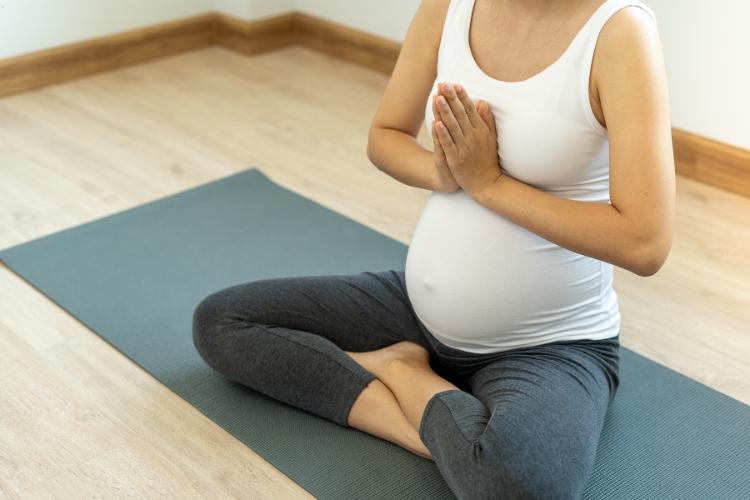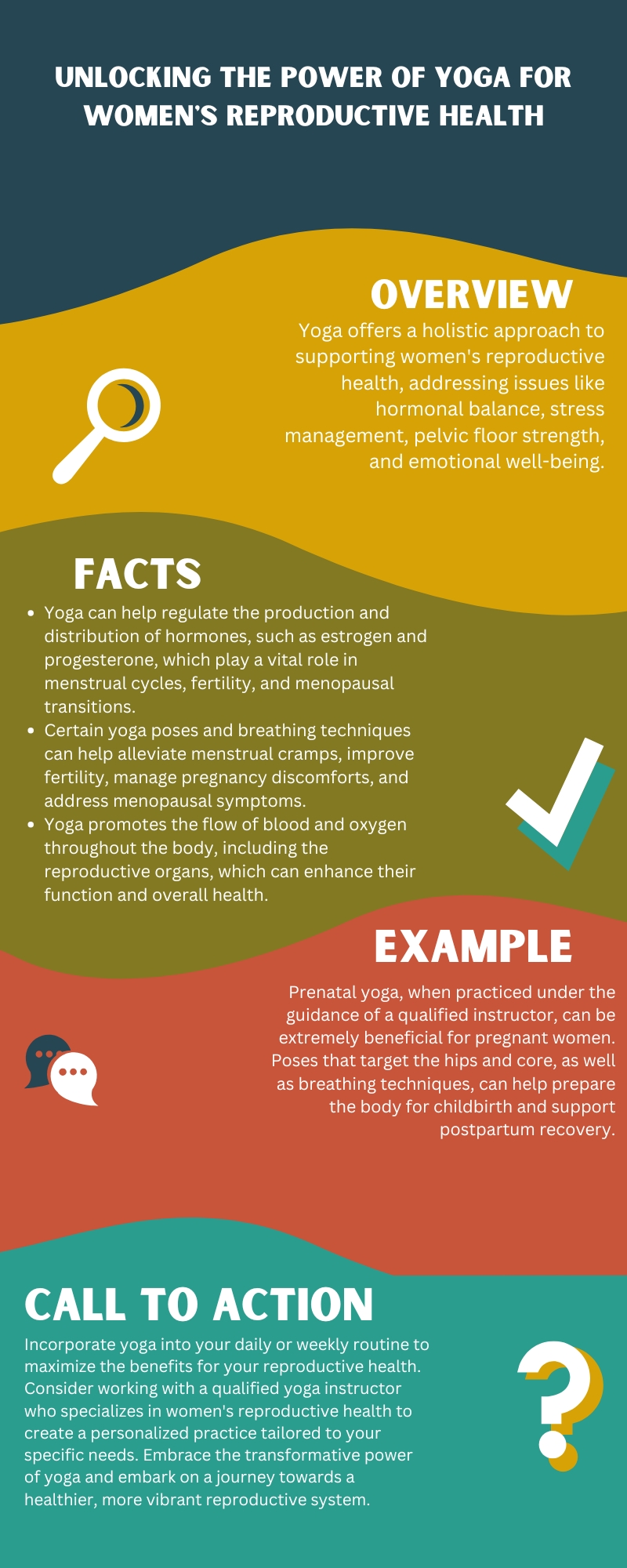As women, our reproductive health is a crucial aspect of our overall well-being. From menstrual cycles to pregnancy and beyond, the intricate workings of our bodies can have a significant impact on our physical, mental, and emotional states.
In this blog article, we’ll explore the transformative power of yoga in supporting and enhancing women’s reproductive health.
Key Takeaways:
- Yoga offers a holistic approach to supporting women’s reproductive health, addressing issues like hormonal balance, stress management, pelvic floor strength, and emotional well-being.
- Specific yoga practices can be tailored to address concerns related to menstrual health, fertility, pregnancy, and menopause.
- Consistency and personalized guidance from a qualified yoga instructor are essential to maximizing the benefits of yoga for reproductive health.
- Addressing common concerns and misconceptions, such as the safety of yoga during pregnancy and menopause, is crucial for a successful yoga practice.
- Integrating yoga into a comprehensive self-care routine, along with other supportive practices, can lead to a healthier, more vibrant reproductive system.

The Connection Between Yoga and Reproductive Health
Yoga is more than just a physical practice; it’s a holistic approach to wellness that integrates the body, mind, and spirit. When it comes to reproductive health, the benefits of yoga are multifaceted:
- Hormonal Balance: Certain yoga poses and breathing techniques can help regulate the production and distribution of hormones, such as estrogen and progesterone, which play a vital role in menstrual cycles, fertility, and menopausal transitions.
- Stress Management: Yoga is renowned for its ability to reduce stress and anxiety, which can have a direct impact on reproductive health. Chronic stress can disrupt the delicate balance of hormones, leading to issues like irregular periods, infertility, and menstrual cramps.
- Pelvic Floor Strengthening: Many yoga poses, especially those that target the core and pelvic region, can help strengthen the pelvic floor muscles, which are crucial for sexual health, childbirth, and post-partum recovery.
- Improved Circulation: Yoga promotes the flow of blood and oxygen throughout the body, including the reproductive organs, which can enhance their function and overall health.
- Emotional Well-being: The meditative and mindful aspects of yoga can help women better understand and manage the emotional ups and downs associated with various reproductive health stages, such as menstruation, pregnancy, and menopause.

Yoga Practices for Specific Reproductive Health Concerns
1. Menstrual Health
- Restorative Yoga: Poses like Child’s Pose, Legs-up-the-Wall, and Savasana can help alleviate menstrual cramps and discomfort by reducing muscle tension and promoting relaxation.
- Hip-Opening Poses: Postures that target the hips, such as Pigeon Pose and Butterfly Pose, can help improve blood flow and relax the pelvic area, providing relief during menstruation.
- Forward Folds: Poses like Standing Forward Fold and Wide-Legged Forward Fold can help regulate the menstrual cycle and reduce the symptoms of PMS.
2. Fertility
- Inversions: Postures like Headstand, Shoulder Stand, and Legs-up-the-Wall can help improve blood circulation to the reproductive organs, which may enhance fertility.
- Backbends: Poses like Camel Pose and Upward-Facing Dog can help open the hips and pelvic area, promoting hormonal balance and creating a more favorable environment for conception.
- Core-Strengthening Poses: Exercises that engage the core, such as Plank and Boat Pose, can help strengthen the pelvic floor and support the reproductive system.

3. Pregnancy
- Prenatal Yoga: Specialized yoga classes for pregnant women focus on poses that alleviate common pregnancy discomforts, promote relaxation, and prepare the body for childbirth.
- Breathing Techniques: Practices like Ujjayi Breath and Alternate Nostril Breathing can help pregnant women manage stress, pain, and the challenges of labor and delivery.
- Postpartum Recovery: Gentle poses, such as the Reclined Butterfly and Supported Bridge Pose, can help new mothers rebuild strength, improve posture, and address postpartum concerns like pelvic floor issues and back pain.
4. Menopause
- Restorative Poses: Gentle, relaxing poses like Child’s Pose, Savasana, and Reclined Bound Angle Pose can help alleviate menopausal symptoms like hot flashes, insomnia, and mood swings.
- Hormone-Balancing Poses: Certain yoga postures, such as Shoulder Stand and Headstand, may help regulate the production of hormones like estrogen and progesterone, which can fluctuate during menopause.
- Breath Work: Practices like Ujjayi Breath and Alternate Nostril Breathing can help manage stress and anxiety, which are common during the menopausal transition.

Incorporating Yoga into Your Reproductive Health Routine
To maximize the benefits of yoga for your reproductive health, it’s essential to incorporate it into your daily or weekly routine. Here are some tips:
- Consult with a Yoga Instructor: Consider working with a qualified yoga teacher, especially one who specializes in women’s reproductive health or prenatal/postpartum yoga. They can provide personalized guidance and recommend the most suitable practices for your specific needs.
- Start Slowly and Listen to Your Body: If you’re new to yoga, begin with gentle, restorative practices and gradually increase the intensity as your body adapts. Pay attention to how your body responds and make adjustments as needed.
- Incorporate Variety: Explore different yoga styles and sequences to target various aspects of your reproductive health, such as menstrual discomfort, fertility, pregnancy, or menopausal symptoms.
- Combine with Other Self-Care Practices: Complement your yoga practice with other supportive self-care activities, such as meditation, journaling, and seeking support from healthcare professionals or women’s health resources.
- Be Consistent: Consistency is key when it comes to experiencing the full benefits of yoga for reproductive health. Aim to practice regularly, whether it’s a daily routine or a few times per week.

Addressing Concerns and Misconceptions
While yoga is generally safe and beneficial for reproductive health, it’s important to address some common concerns and misconceptions:
| Concern | Explanation |
|---|---|
| Yoga during Pregnancy | Prenatal yoga, when practiced under the guidance of a qualified instructor, can be extremely beneficial for pregnant women. However, it’s crucial to avoid certain poses and modifications as needed, particularly in the later stages of pregnancy. |
| Yoga and Fertility | While yoga can support fertility, it’s not a substitute for medical treatment or consultation with a healthcare professional. Yoga should be used as a complementary practice alongside any necessary medical interventions. |
| Yoga and Menopause | Yoga can be a valuable tool for managing menopausal symptoms, but it’s essential to work with an instructor who understands the unique needs and considerations of women during this transitional phase. |
Remember, as with any physical activity, it’s always best to consult with your healthcare provider before starting or modifying your yoga practice, especially if you have any pre-existing medical conditions or concerns.
Conclusion
Yoga is a powerful tool that can profoundly impact women’s reproductive health. By integrating yoga into your self-care routine, you can work towards hormonal balance, stress management, pelvic floor strengthening, and overall emotional well-being.
Embrace the transformative power of yoga and embark on a journey towards a healthier, more vibrant reproductive system.
FAQs
1. Is yoga safe during pregnancy?
Prenatal yoga, when practiced under the guidance of a qualified instructor, can be extremely beneficial for pregnant women. However, it’s crucial to avoid certain poses and modifications as needed, particularly in the later stages of pregnancy. It’s important to consult with a healthcare provider before starting or modifying a yoga practice during pregnancy.
2. Can yoga help with fertility?
While yoga can support fertility by improving blood circulation, hormonal balance, and pelvic floor strength, it should not be seen as a substitute for medical treatment or consultation with a healthcare professional. Yoga can be a valuable complementary practice alongside any necessary medical interventions for fertility.
3. Is yoga helpful for menopausal symptoms?
Yoga can be a valuable tool for managing menopausal symptoms, such as hot flashes, insomnia, and mood swings. However, it’s essential to work with an instructor who understands the unique needs and considerations of women during this transitional phase. Certain restorative poses, hormone-balancing postures, and breathing techniques can help alleviate menopausal discomforts.
4. How often should I practice yoga for reproductive health?
Consistency is key when it comes to experiencing the full benefits of yoga for reproductive health. Aim to practice regularly, whether it’s a daily routine or a few times per week. It’s also important to listen to your body and make adjustments as needed. Working with a qualified yoga instructor can help you develop a personalized practice that meets your specific reproductive health goals.


